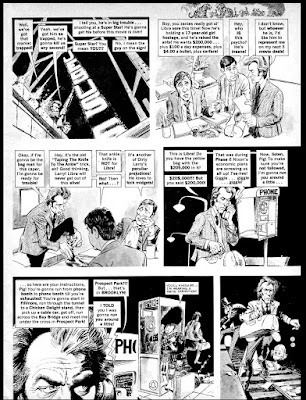Pale Rider Ale first became available in August 1997. It was
first served up through Clint’s once owned restaurant on Carmel’s San Carlos
Street, The Hog's Breath Inn. The beer was of course named after Clint's 1985
Western Pale Rider. "Proudly brewed for Clint Eastwood by his friends at
Celis Brewery" proclaims the attractive label. Bottled by Celis Brewery,
an Austin, Texas, subsidiary of the Miller Brewing Company, Pale Rider Ale was first
introduced into the Carmel-Monterey area before eventually going on sale throughout
the West. But for Clint, this wasn’t just another business venture; instead it
was produced for a charitable cause. All of Eastwood's proceeds from Pale Rider
Ale sales were distributed and shared among his favourite charities around the
country, including the Carmel Youth Centre and the Boys and Girls Club of the
Monterey Peninsula.
 It’s hard to ignore what fellow actor and close friend Paul Newman
had done for charity through his pasta sauce and vinegar dressings. In fact, over
$500 million has been generated for charity since 1982. "I'm not really in
the beer business," Eastwood said, "Anything that I make from this
will go to charity, like Paul Newman does with his spaghetti sauce."
It’s hard to ignore what fellow actor and close friend Paul Newman
had done for charity through his pasta sauce and vinegar dressings. In fact, over
$500 million has been generated for charity since 1982. "I'm not really in
the beer business," Eastwood said, "Anything that I make from this
will go to charity, like Paul Newman does with his spaghetti sauce."
In typical light-hearted style, Clint made good use of his
image and used his friend Newman’s success to help promote the new Ale. The result
was a cleverly designed promotional poster with a tagline proclaiming - ‘You
Didn't Expect Clint Eastwood to Make a Salad Dressing Did You?
A lot of names were tested at first before finally settling
on the Pale Rider brand name. Everyone's first choice for the beer's name was
simply "Hog's Breath", named after the famous Carmel restaurant. That
name could not be cleared and was simply due to fact there were many other
bar's across the country which shared the same name.
Clint himself preferred "The Beer with No Name", which
was of course a play on the anonymous antihero he portrayed in the three
"Spaghetti Westerns" he made between 1864-1966.
After all of the legal tangles of getting the name chosen were
straightened, Clint helped in testing the beer to get the taste just right.
"I don't drink much. When I do, I prefer a beer or a glass of wine. But testing
wasn't all that tough," Eastwood jokingly said.
Sample taste tests were held at the famous jazz festival that
Clint did at Carnegie Hall in early 1997, it was also sampled again at a cast
party in Savannah during the shooting for his film, 'Midnight in the Garden of
Good and Evil.'
Unfortunately, the Pale Rider Ale story was rather short
lived - for reasons that have not really been revealed. But in 2000, Celis
Brewery discontinued producing Pale Rider Ale.
(Left, Clint wearing a Pale Rider Ale shirt)
Review:
While that
Bud may be for you, this beer is for Clint. The beer is a medium golden in
colour and produces a healthy head of
foam with a moderately paced pour. Nose is very light here. So far, everything
here is shouting light bodied American beer, and the first sip cements this
opinion.
The beer is drinkable, but light bodied, and a refreshing first beer
of the night. Sort of a Bud or Miller with a little ale fruitiness, just a
touch mind you. Clint boasts that five hop varieties are used, but I would say
in limited quantities, as the finish is balanced slightly towards the sweet
side. The beer is clean and crisp, and is a good example of an accessible,
light ale.
Memorabilia and collectables:
Material relating to Pale Rider Ale remains collectable,
however – it is often hard to find. My own collection only consists of the
sturdy and well-made 6 pack holder (held by Clint in photo left) and an original
T-Shirt which I have to say, I have never seen for sale or on any auction site.
The occasional beer bottle, bottle top or beer glasses sometimes make an appearance
– but hardly regularly. The poster relating to Paul Newman’s salad dressing (17.25"
x 24.5") is also a rare one, so rare in fact, it’s extremely hard to find
a good enough image anywhere on the web.
There was also a very rare vinyl pub banner
produced. The description read - The banner is stamped from the Celis Brewery,
Austin, TX with the unique # 0A8816 WM 90. The banner (48" wide x 36"
high) is stitched all around, with brass eyelets for hanging. The banner
caption reads: "Its spirited nature and smooth drinkin' style just might
take you by surprise. Proudly brewed for Clint Eastwood by his friends at Celis
Brewery, Austin, Texas. All of Clint Eastwood's proceeds from the sale of this
product are being donated to selected charities."
Below: The Pale Rider Ale poster relating to Paul Newman's salad dressing
Below: The very rare vinyl pub banner for Pale Rider Ale
Below: 2 different examples of Pale Rider Ale glasses
Below: A rare publicity photo used for promotional purposes
Below: The front (breast pocket) and impressive reverse of the original Pale Rider Ale T-Shirt
Below: Clint samples his product at The Hog's Breath Inn, Carmel, Tuesday, July 22nd 1997
Updated 14/01/2018 Below: I was lucky enough to add this original and unused Beer bottle label to my collection - a nice little item to look out for


















































